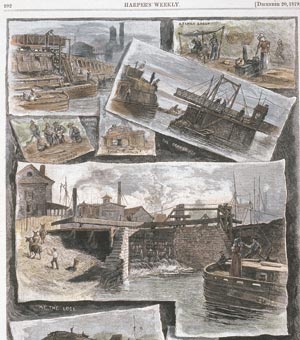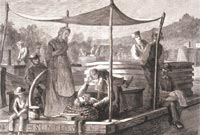

About nine we were under way altho' not till after a great deal of pushing and hauling
... the boats jumping and thumping against one another, each one being desirous of getting into
the lock as soon as possible ... (the boatmen) running to and fro across the deck, blowing the
bugles, halloing to the driver ...
-- Jonathan Pearson, Diary, August 5, 1833
The Erie Canal had an extraordinary impact on the people and communities along its banks. Villages barely on the map before the canal was built were transformed into major cities in just a few years. Between 1820 and 1850 Syracuse grew from a town of less than 2,000 residents to one of over 25,000. Rochester, a town of 331 residents in 1815, grew to nearly 10,000 by 1830. By 1850, Albany, Troy, Utica, Rome, Lockport, and Buffalo all grew to double or triple the size they had been before the canal opened.
Visitors to these cities frequently expressed their amazement at the rapid growth and prosperity that was occurring. Nathaniel Hawthorne commented on Rochester, saying "The town had sprung up like a mushroom ... " (Hawthorne, Rochester, 1835), and on reaching Buffalo, one traveler stated: "The enterprise exhibited at Buffalo almost makes one catch his breath, particularly when thinking what the name denotes, and what it was thirty years since, and comparing it with what it is now. I had thought the other western towns great, but at Buffalo I almost rubbed my eyes to see if all was real." (Caroline Gilman, The Poetry of Travelling in the United States, 1838)
The opportunities for commerce created by the canal brought enormous prosperity to the cities along its route, from New York City to Buffalo. Factories and mills sprang up along the banks of the canal in places like Little Falls and Rochester where nearby rivers provided the water power and the canal provided a fast, cheap means of transporting goods. By 1850, Albany had become a major port; Troy, Cohoes, and Amsterdam were leading producers of textiles; Schenectady was a transportation and manufacturing hub; Syracuse was the country's leading exporter of salt; Rochester was one of the largest flour milling cities in the country; and Buffalo was the premier gateway to the west.
 The business of moving
goods and people along the canal involved thousands of boats and their crews. In 1845, there
were 4,000 boats on the canal, operated by 25,000 men, women, and children. Packet boats,
which carried passengers, were largely operated by boat companies, while cargo boats tended to
be family owned. A typical crew included a captain, a steersman, a cook, a deckhand, and
hoggees, who drove the teams that pulled the canal boats. In addition, thousands were employed
to maintain and operate the canal itself, including lock tenders, toll collectors, bridge operators,
surveyors, repair crews, and bank patrollers, whose job, called the bankwatch, required a man to
patrol a ten-mile stretch of canal looking for leaks and breaks in the canal bank. There were also
merchants, hostellers, liverymen, and shopkeepers along the route who fed, clothed, housed, and
supplied those employed on the canal.
The business of moving
goods and people along the canal involved thousands of boats and their crews. In 1845, there
were 4,000 boats on the canal, operated by 25,000 men, women, and children. Packet boats,
which carried passengers, were largely operated by boat companies, while cargo boats tended to
be family owned. A typical crew included a captain, a steersman, a cook, a deckhand, and
hoggees, who drove the teams that pulled the canal boats. In addition, thousands were employed
to maintain and operate the canal itself, including lock tenders, toll collectors, bridge operators,
surveyors, repair crews, and bank patrollers, whose job, called the bankwatch, required a man to
patrol a ten-mile stretch of canal looking for leaks and breaks in the canal bank. There were also
merchants, hostellers, liverymen, and shopkeepers along the route who fed, clothed, housed, and
supplied those employed on the canal.
http://www.eriecanal.org/UnionCollege/Bankwatch.html